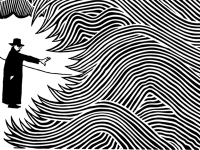 William Paley (1743 – 1805) was a British philosopher whose writings on natural theology and moral/political philosophy were largely influential amongst British and American thinkers. His most famous argument is called the watchmaker analogy, where Paley makes an inference from the complexity of living systems to a “designer”.
William Paley (1743 – 1805) was a British philosopher whose writings on natural theology and moral/political philosophy were largely influential amongst British and American thinkers. His most famous argument is called the watchmaker analogy, where Paley makes an inference from the complexity of living systems to a “designer”.
In crossing a heath, suppose I pitched my foot against a stone, and were asked how the stone came to be there; I might possibly answer, that, for anything I knew to the contrary, it had lain there forever: nor would it perhaps be very easy to show the absurdity of this answer. But suppose I had found a watch upon the ground, and it should be inquired how the watch happened to be in that place; I should hardly think of the answer I had before given, that for anything I knew, the watch might have always been there. … There must have existed, at some time, and at some place or other, an artificer or artificers, who formed [the watch] for the purpose which we find it actually to answer; who comprehended its construction, and designed its use. … Every indication of contrivance, every manifestation of design, which existed in the watch, exists in the works of nature; with the difference, on the side of nature, of being greater or more, and that in a degree which exceeds all computation.
—William Paley, Natural Theology (1802)
Paley’s argument can be broadly categorised as a type of teleological argument, and a distinctly modern one. It is modern firstly because it regards the world in mechanistic terms i.e. likening a human being to a watch, and secondly because it regards teleology as imposed on the mechanism extrinsically. Essentially, the world is thought of as a type of artifact rather than natural, and the “designer” as a type of tinkering artificer, albeit a very powerful one. This tinkerer is very similar to the deistic god of the Enlightenment developed by thinkers such as Voltaire.
And of course this is exactly the criticism that David Hume makes in his Dialogues Concerning Natural Religion. Hume says that if all that is necessary to explain the appearance of design in complex systems is the characteristics that human beings possess, then there is no need to assume Paley’s desinger has divine attributes such as omnipotence, omnipresence or omniscience. Additionally, Paley’s (and other modernists) denial of final causality leaves open the question of the intelligibility of the kind of efficient causality Paley uses as a premise in his analogy.
One may note the difference between Aquinas’ fifth way and Paley’s analogy. Aquinas argues from the intelligibility of efficient causality, to the reality of final causality and from there the necessity a being that is purely actual. Aquinas’ argument avoids Hume’s criticisms because of the intrinsic and directive nature of final causality and the divine attributes that a purely actual being must possess.
